Book contents
- How the East Was Won
- LSE International Studies
- How the East Was Won
- Copyright page
- Dedication
- Contents
- Maps
- Preface and Acknowledgements
- Introduction
- 1 From the Rise of the West to How the East Was Won
- 2 The Eurasian Transformation
- 3 The Rise of Asia’s Terrestrial Empires
- 4 European Infiltration and Asian Consolidation in Maritime Asia, 1600–1700
- 5 The Great Asian Divergence
- 6 The East India Company and the Rise of British India, 1740–1820
- 7 Crises of Empire and the Reconstitution of International Orders in South and East Asia, 1820–1880
- Conclusion
- References
- Index
1 - From the Rise of the West to How the East Was Won
Published online by Cambridge University Press: 01 October 2021
- How the East Was Won
- LSE International Studies
- How the East Was Won
- Copyright page
- Dedication
- Contents
- Maps
- Preface and Acknowledgements
- Introduction
- 1 From the Rise of the West to How the East Was Won
- 2 The Eurasian Transformation
- 3 The Rise of Asia’s Terrestrial Empires
- 4 European Infiltration and Asian Consolidation in Maritime Asia, 1600–1700
- 5 The Great Asian Divergence
- 6 The East India Company and the Rise of British India, 1740–1820
- 7 Crises of Empire and the Reconstitution of International Orders in South and East Asia, 1820–1880
- Conclusion
- References
- Index
Summary
This chapter presents the book’s research design and central argument. I begin by considering accounts of the ‘rise of the West’ that explain Western expansion through reference to European exceptionalism, global logics of uneven and combined development, or the facilitating role of local networks and patterns of collective identity in enabling colonial conquest. Having critiqued these accounts, I then advocate an alternative Eurasia-centric approach that stresses the vital parallels and interconnections between ‘barbarian’ Mughal, British and Manchu conquests in early modern South and East Asia. A combination of military, economic, cultural and administrative developments across Eurasia made it easier for ‘barbarians’ to conquer and preserve empires on a subcontinental scale. After 1500, formerly stigmatized outsiders from Eurasia’s steppe, sea and forest frontiers capitalized on these opportunities to carve out the empires that eventually crystallized into the modern post-imperial states of India and China. These empires emerged from ‘barbarian’ efforts to overcome similar challenges, and yielded strikingly similar incorporative ideologies and models of imperial governance.
- Type
- Chapter
- Information
- How the East Was WonBarbarian Conquerors, Universal Conquest and the Making of Modern Asia, pp. 22 - 61Publisher: Cambridge University PressPrint publication year: 2021

